
|
xTuple ERP Reference Guide |
To create a new Opportunity, select the "New Opportunity" option. The following screen will appear:
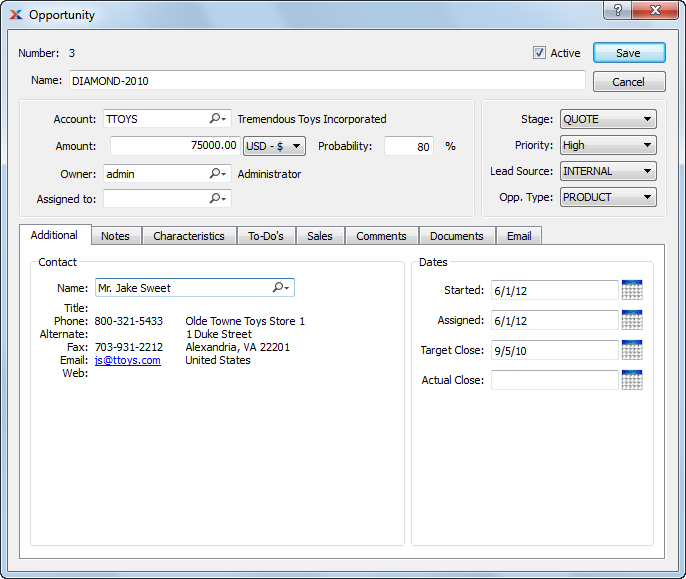
When creating a new Opportunity, you are presented with the following options:
Displays the system-defined number used to identify the Opportunity.
Enter a name to identify the Opportunity.
Select to specify the Opportunity is active. If not selected, the Opportunity will be marked as inactive, causing it to be hidden in some lists.
Specify the Account the Opportunity is associated with.
Enter the monetary value of the Opportunity.
Project the likelihood the Opportunity will be closed.
Specify the user who owns the Opportunity.
Specify the user the Opportunity is assigned to.
Specify the current Stage of the Opportunity. It's possible an Opportunity will be automatically marked as inactive when it reaches a certain stage, depending on how your system is configured. To learn more about configuring your system to automatically mark Opportunities as inactive when they reach a certain stage, see Section 10.2.8.1, “Opportunity Stage”.
Specify the priority level for the Opportunity.
Specify the source which generated the Opportunity.
Specify the type of Opportunity.
Enter the name of the Contact—or select a name from the Contacts list. Details for the Contact will be shown after selection.
Enter dates for the following:
Specify the date when the Opportunity was first identified. This date will be auto-populated when the Opportunity is created.
Specify the date when the Opportunity was assigned. This date will be auto-populated when the Opportunity is assigned.
Specify the date you expect the Opportunity will close.
Specify the date when the Opportunity closed.
To add Notes related to the Opportunity, select the "Notes" tab. The following screen will appear:
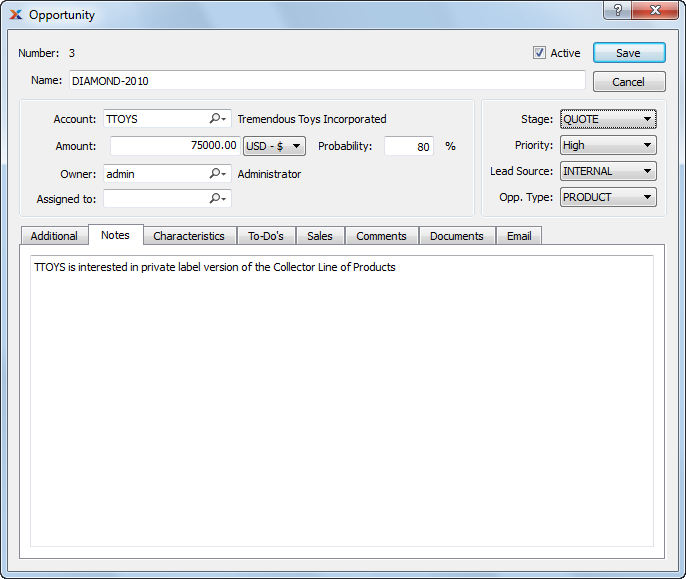
This is a scrolling text field with word-wrapping for entering Notes related to the Opportunity. Any Notes entered on this screen are for internal purposes only.
To associate Characteristics with an Opportunity, select the "Characteristics" tab. The following screen will appear:
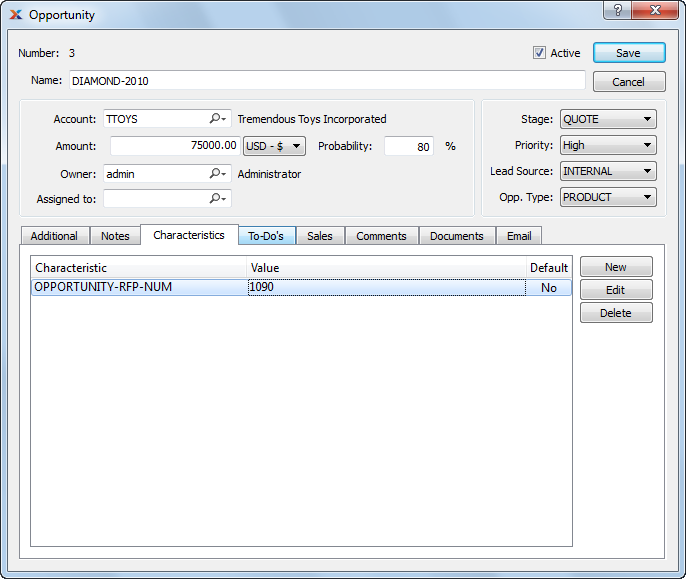
To create a new Characteristic for your current context, select the NEW button from the Characteristics list. The following screen will appear:
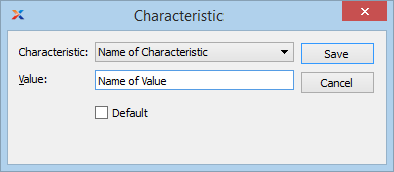
When creating a new Characteristic, you are presented with the following options:
Select a Characteristic from the list of Characteristics available for your current context. To learn more about how Characteristics are linked to specific contexts, please see Section 9.2.2.1, “Characteristic”.
Enter a value to associate with the Characteristic.
In some contexts, the default option will appear. Select if the Value entered is the default Value for the specified Characteristic. Default Values will always be listed first where Characteristics are used.
To associate To-Do List items with an Opportunity, select the "To-Do"s" tab. The following screen will appear:
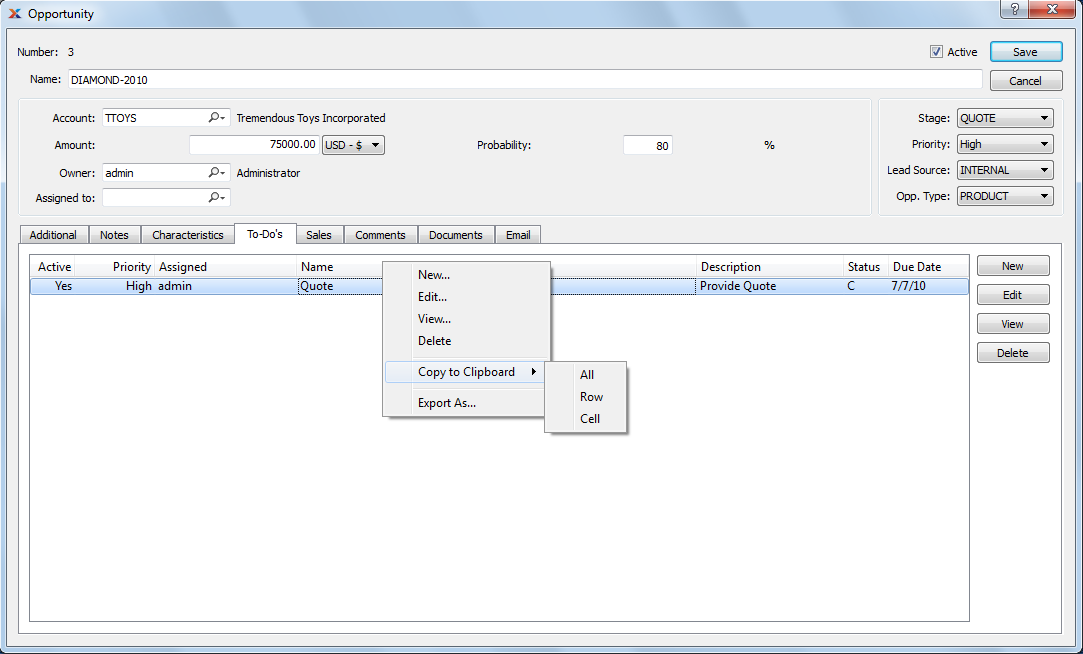
When associating To-Do items with an Opportunity, you are presented with the following options:
Display lists To-Dos related to the Opportunity.
To manage and track Quotes and Sales Orders associated with an Opportunity, select the "Sales" tab. The following screen will appear:
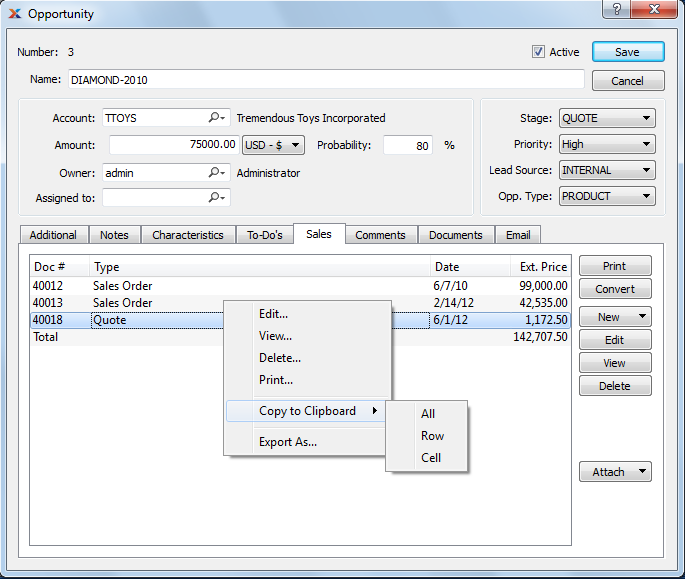
When managing and tracking Quotes and Sales Orders associated with an Opportunity, you are presented with the following options:
Display lists Quotes and Sales Orders associated with the Opportunity.
The following buttons are unique to this screen:
Select to convert a Customer Quote to a Sales Order. All Quote Line Items must have valid Item Sites for a Quote to be converted successfully. Also, you may not convert Quotes written for Prospects.
By default, the Quote Number will be assumed by the Sales Order when a Quote is converted to a Sales Order.
Select to associate a Quote or Sales Order with the Opportunity.
To add Comments to an Opportunity, select the "Comments" tab. The following screen will appear:
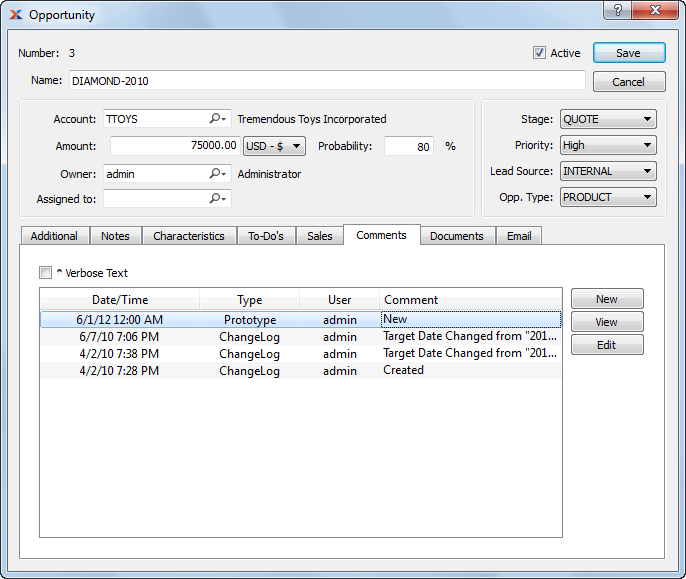
When adding or reviewing Comments, you are presented with the following options:
Select to display all Comments in the list in an expanded view which includes the entire text of each Comment. To edit a Comment, simply select the "Edit" link next to the Comment. That link will not be shown for Changelog Comments, which can't be edited. If the "Verbose Text" option is not selected, the Comment list will display only header level information for each Comment.
Display lists Comments related to the record.
The following buttons are available:
Opens screen for creating a new Comment.
Highlight a Comment and then select this button to reach a read-only view of the "Edit" screen.
Enables you to edit highlighted Comments—as long as the Comments are not "ChangeLog" Comments. ChangeLog Comments are system-generated and may not be edited. The edit screen is the same as that for creating a new Comment—except that when editing, the fields will contain Comment information. Double-clicking on a Comment will also bring you to the editing screen.
To enter a new Comment, select the NEW button. The following screen will appear:

Select a Comment Type from the drop-down list to classify the Comment. This is a required step. Comment Types may be system-defined (i.e., "ChangeLog" and "General") or user-defined, as described in Section 13.2.2, “Comment Types”. Once you have specified a Comment Type, begin typing your Comment in the main text area. The text area features word-wrapping and scroll-bar support for longer Comments.
The following buttons are unique to this screen:
Select to show the complete list (i.e., "thread") of Comments associated with the record. To hide the list, simply select the SHOW MORE button again. The Comment thread will show the most recent Comment first.
To view the documents associated with an Opportunity, select the "Documents" tab. The following screen will appear:
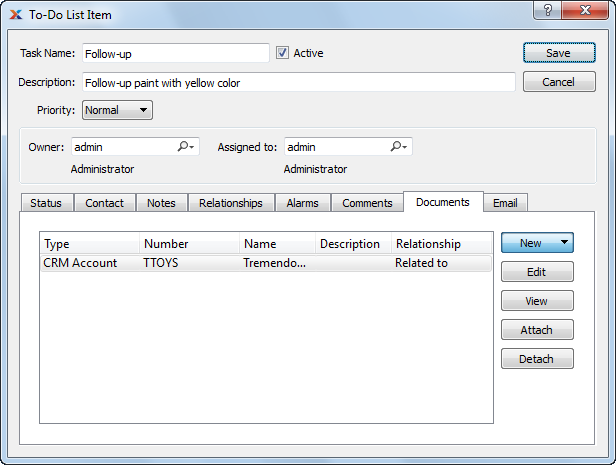
Opportunity Documents
When associating documents, you are presented with the following options:
Select to create a new document and associate it with the current record. You may create the following document types:
Select to create a new Image association.
Select to create a new Fixed Asset association.
Select to create a new Maintenance Order association.
Select to create a new Incident and associate it.
Select to create a new Project and associate it.
Select to create a new Opportunity and associate it.
Select to create a new To-Do and associate it.
Enables you to edit associated documents. The edit screen is the same as that for creating a new document—except that when editing, the fields will contain document information. Double-clicking on a document will also bring you to the editing screen.
Highlight a document and then select this button to reach a read-only view of the "Edit" screen
Select to associate already-existing documents. The following document types may be attached: Contact, Account, Customer, Employee, File, Image, Incident, Item, Opportunity, Project, Purchase Order, Sales Order, Vendor, Web Site, Work Order.
Highlight a document and then select this button to remove the association.
To associate already-existing documents, select the ATTACH button. The following screen will appear:
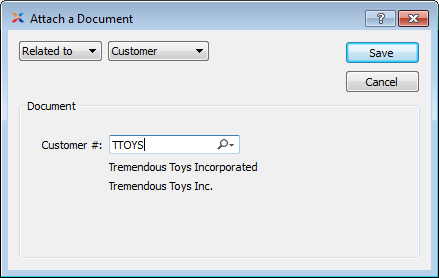
When associating already-existing documents, you are presented with the following options:
Indicate how the document is related to the current record. The following relationship options are available: Related to, Parent of, Child of, Duplicate of.
Specify the kind of document you want to associate. The following document types may be attached: Contact, Account, Customer, Employee, File, Image, Incident, Item, Opportunity, Project, Purchase Order, Sales Order, Vendor, Web Site, Work Order. When associating Files, you will also be given the option to save the File to the database.
There is no file size restriction when saving Files to the database. However, excessively large files could cause storage and performance issues.
Use the lookup field to identify the specific document you want to attach. The data entry options will vary depending on the document type you select.
To view Email associated with an Opportunity, select the "Email" tab. The following screen will appear:
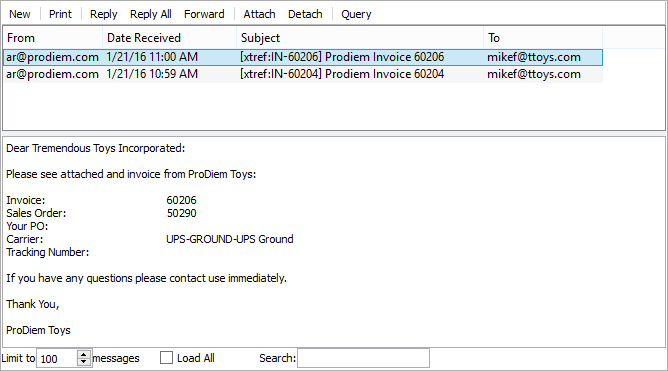
View Associated Emails
When viewing associated Emails, you are presented with the following options:
Display lists associated Emails.
The content of a highlighted Email will be displayed here.
Specify the maximum number of associated Emails you want to be displayed in the Email list. If the list is extremely long, you may experience some slowness when opening the screen.
Select to load all associated Emails into the list.
Enter a string of letters or complete words to search for matches in the list of associated Emails. The search will scan through subject lines, to addresses, and from addresses.
The following buttons are unique to this screen:
Select to send a new Email, using the default Email program on your computer.
Highlight an Email and then select this button to print a copy of the Email.
Highlight an Email and then select this button to reply to the Email's sender, using the default Email program on your computer.
Highlight an Email and then select this button to reply to everyone associated with the Email, using the default Email program on your computer.
Highlight an Email and then select this button to forward the Email to another person(s), using the default Email program on your computer.
Highlight an Email and then select this button to attach an Email associated with a Contact in your Contact list.
Highlight an Email and then select this button to remove the associated Email from the list.